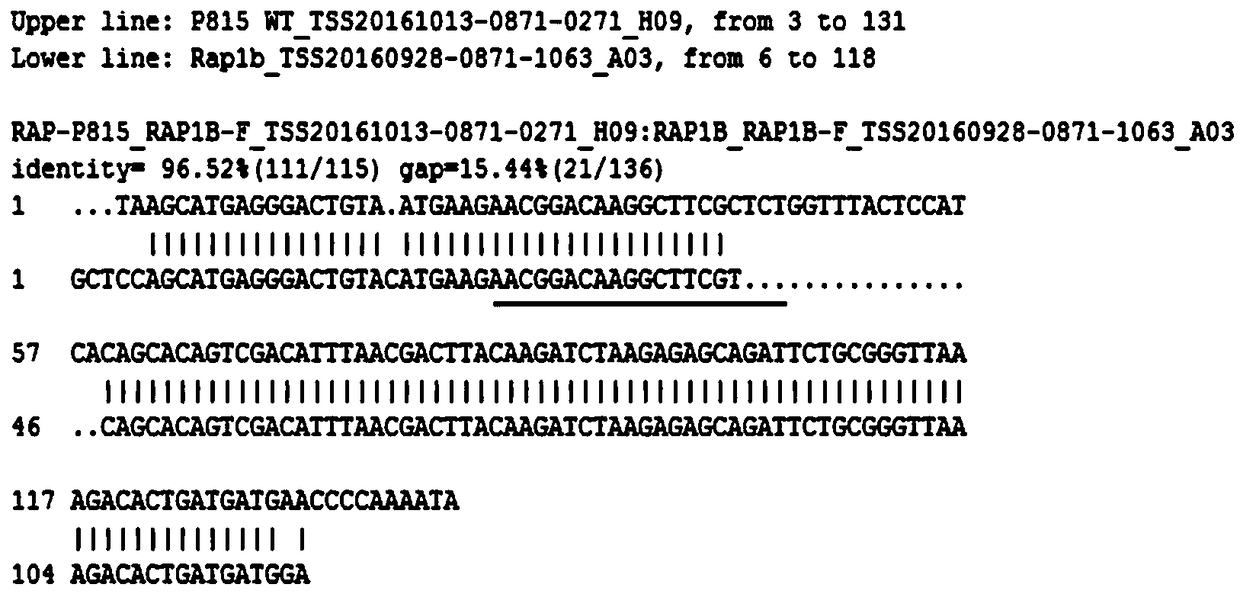Purpose of Rap1b gene
A gene and drug technology, applied in genetic engineering, microbial determination/inspection, and other methods of inserting foreign genetic materials, etc., can solve the problems of long treatment course, high cost, and insignificant effect.
- Summary
- Abstract
- Description
- Claims
- Application Information
AI Technical Summary
Problems solved by technology
Method used
Image
Examples
Embodiment 1
[0048] Example 1: Constructing a plasmid capable of editing the target gene and transfecting it into the cells so that it can function in the cells, and then screening the Rap1b knockout cell line for subsequent experiments;
[0049] (1) Plasmid construction
[0050] A. Design and synthesis of gRNA
[0051] To design a pair of gDNA of about 20bp, we can design it through the following online tool: CRISPRDesign from MIT: http: / / crispr.mit.edu / ; Design the gRNA sequence targeting the Rap1b coding gene, as shown in the following table:
[0052] Table 1: gRNA-Rap1b nucleic acid sequence
[0053]
[0054] Note: The lowercase part is the nucleic acid sequence connected to the plasmid;
[0055] B. Cloning sgRNA into pSpCas9(BB) plasmid
[0056] ① Dissolve each gRNA to a final concentration of 100 μM, and phosphorylate and anneal the sgRNA according to the following formula;
[0057] Element
Dosage (μL)
sgRNA forward sequence (100μM)
1
sgRNA r...
Embodiment 2
[0095] The proliferation rate of mast cells has a certain influence on the overall degranulation level of cells, and the mast cell sensitizer C48 / 80 can induce mast cell activation and degranulation, and the degree of degranulation is related to the ability of mast cells to accept C48 / 80 sensitization signals certain correlation. In order to verify the effect of Rap1b on the proliferation of mast cells and the acceptance of C48 / 80 signals, we used CCK-8 assay to detect the proliferation rate of P815WT and Rap1b KO cells and the inhibition rate of cell proliferation induced by C48 / 80 (10 μg / mL) ,Specific steps are as follows:
[0096] (1) Culture and passage of mast cell lines P815WT and Rap1b KO cells
[0097] A. Cultivation of P815WT and Rap1b KO cells: P815 was cultured in high-glucose DMEM medium containing 10% fetal bovine serum (FBS), 1% penicillin and streptomycin at 37°C and 5% CO 2 Environment;
[0098] B. Passage of P815WT and Rap1b KO cells: When the cell density ...
Embodiment 3
[0110] The degree of degranulation of mast cells directly reflects the state of allergic reactions in the body. The pre-synthesized granule medium in the cells contains substances such as tryptase and β-hexosaminidase, which can be used as markers of mast cell degranulation. In order to verify the effect of Rap1b on mast cell activation and degranulation, toluidine blue staining, ELISA and chromogenic methods were used in this experiment. The specific steps are as follows:
[0111] (1) Culture and passage of mast cell lines P815WT and Rap1b KO cells
[0112] A. Cultivation of P815WT and Rap1b KO cells: P815 was cultured in high-glucose DMEM medium containing 10% fetal bovine serum (FBS), 1% penicillin and streptomycin at 37°C and 5% CO 2 Environment;
[0113] B. Passage of P815WT and Rap1b KO cells: When the cell density in step A reaches 80%, it needs to be passaged. Collect the cell culture solution in the culture bottle into a centrifuge tube, rinse with preheated phosphat...
PUM
 Login to View More
Login to View More Abstract
Description
Claims
Application Information
 Login to View More
Login to View More - R&D
- Intellectual Property
- Life Sciences
- Materials
- Tech Scout
- Unparalleled Data Quality
- Higher Quality Content
- 60% Fewer Hallucinations
Browse by: Latest US Patents, China's latest patents, Technical Efficacy Thesaurus, Application Domain, Technology Topic, Popular Technical Reports.
© 2025 PatSnap. All rights reserved.Legal|Privacy policy|Modern Slavery Act Transparency Statement|Sitemap|About US| Contact US: help@patsnap.com



